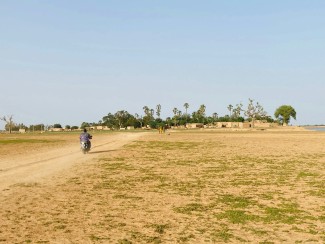Prior to the onset of the pandemic, global public debt levels were at record highs. The pandemic exacerbated debt vulnerabilities and increased financing needs in many countries, particularly low-income countries. Addressing these vulnerabilities – and helping to resolve them – is and will be a complex undertaking.
The pandemic is adding to spending needs as low-income countries seek to mitigate the health and economic effects of the crisis. At the same time, revenues are falling due to lower growth and trade, increasing these countries’ debt burdens. Some vulnerable countries, including those in the least developed country (LDC) category, are facing higher financing costs or already had very limited access to external financing. As a result, the pandemic has adversely affected these countries’ solvency and liquidity indicators. Over half of low-income countries are now assessed to be at high risk of or already in debt distress, according to the joint IMF World Bank Debt Sustainability Framework for Low Income Countries.
The IMF is taking a deliberate, case-by-case approach to help member countries address their debt challenges, while also engaging with the private sector and creditor countries on necessary reforms to the international debt architecture.
Tackling debt
Effectively addressing debt risks requires an approach that is both proactive and tailored to specific country circumstances. The IMF offers its member countries policy advice, financing and capacity development to ensure debt sustainability and to avoid a disorderly debt restructuring. Debt risks are identified and overcome through debt sustainability analysis and policy advice. Lending is made to low-income countries at below market rates that also helps to catalyze support from donors and thereby prevent liquidity shortfalls. Technical assistance and training on improving debt management and debt transparency are provided. In this priority agenda, the IMF partners closely with the World Bank and other multilateral development banks.
When debt is unsustainable, IMF-supported programs complement the necessary debt restructuring by countries through the provision of sound economic policies and fresh financing. The IMF is also providing debt relief through grants to the 29 poorest countries under the Catastrophe Containment and Relief Trust.
The IMF and World Bank urged G20 countries in March 2020 to provide debt service relief for the poorest countries. The G20 Debt Service Suspension Initiative (DSSI) applied to debt service due between May 1 and December 31, 2020. In 2020, 43 countries benefitted from US$5.7 billion debt service suspension, with African countries comprising about 65% of the participants. Given the prolonged impact of the pandemic, the G20 agreed to extend the DSSI through June 2021, and will consider a further extension in April 2021.
New challenges, new framework
In November 2020, the G20 endorsed the Common Framework (CF) for debt treatments, creating a tool for comprehensive debt treatments tailored to the nature and depth of debt challenges in each country. The CF aims to address sovereign debt challenges and ensure the broad participation of creditors with fair burden sharing. This is a highly welcome development. Importantly, this initiative includes official creditors previously outside of the established Paris Club process. Paris Club is an informal group of official creditors whose role is to find coordinated and sustainable solutions to the payment difficulties experienced by debtor countries. Paris Club creditors provide debt treatments to debtor countries in the form of rescheduling, which is debt relief by postponement or, in the case of concessional rescheduling, reduction in debt service obligations during a defined period (flow treatment) or as of a set date (stock treatment). An effective implementation of the Common Framework can provide important relief to the poorest debt-stricken countries and also set the stage for a more universal and possibly permanent framework for efficient sovereign debt resolution.
The Common Framework facilitates coordination of debt treatments tailored to the specific situation of the debtor country, based on an IMF-supported stabilization and reform program. Unlike the DSSI, it requires that participating debtor countries seek treatment on comparable or better terms from other creditors, including the private sector. So far, Chad, Ethiopia and Zambia have applied for debt relief under the Common Framework. The IMF is working closely with both debtor countries and creditors – including China – so this tool can be implemented effectively to help those and other debtor countries in need.
The involvement of the private sector in debt restructurings is an essential component of the Common Framework. It ensures fairer burden sharing and is essential to unlocking support for debt relief by bilateral official creditors. When the burden is unsustainable, a private sector contribution to deep debt relief will be required.
When debt is sustainable, yet the country faces temporary liquidity issues, the Common Framework can be used to coordinate maturity extensions across major creditors. In such a setting, treating private creditors on comparable terms need not mean that private sector creditors will necessarily suffer losses. On the contrary, a coordinated rollover should make it easier for the debtor country to recover and eventually service its debts, benefitting creditors as well.
Transparency
Finally, an essential aim of a debt architecture that promotes stability is debt transparency. Without the full picture of a government’s outstanding debt and contingent liabilities, as well as its terms, debtors and creditors cannot make informed decisions to ensure debt remains sustainable, and accountability is weakened by a lack of public information on public debt. That said, debt transparency is not an easy fix and depends on a multitude of factors, such as a country’s institutional capacity, legal frameworks, governance, and civil service organization more broadly.
Taking these considerations into account, the IMF has been working closely with the World Bank to enhance transparency. Efforts have focused on scaling up capacity development efforts to enhance public debt reporting in borrowing countries. For example, Malawi significantly enhanced its debt transparency supported by tailor-made capacity development provided by the IMF and the World Bank. For instance, it now provides semi-annual reporting on its public debt position within a lag of three months, including information on the composition and holders of the debt. Standards for debt statistics have been set, and public debt reported by borrowers through their databases has been disseminated to the general public. In addition, higher requirements on debt reporting for IMF-World Bank country assessments are being considered, to be used in debt sustainability analysis. The recent reform of the Policy on Debt Limits in IMF-supported Programs aims to further raise the bar on debt disclosure to the IMF.
Many emerging market and developing countries are facing significant risk of debt distress, and since the onset of the pandemic some have announced their intention to seek debt restructuring. More countries may end up in a similar situation. What is most important is to ensure that support and action happens sooner rather than later.
If you would like to reuse any material published here, please let us know by sending an email to EIF Communications: eifcommunications@wto.org.



